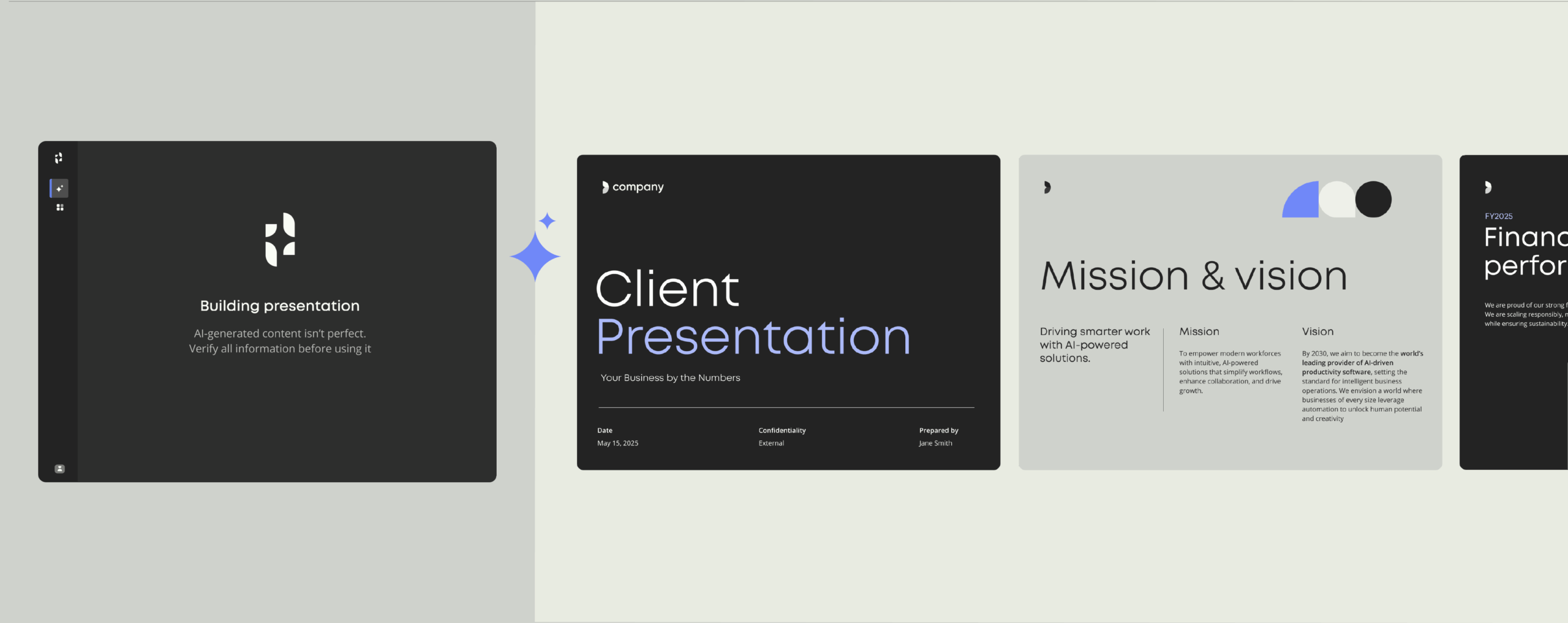What is document generation? (And the 10 best tools in 2024)

This is your ultimate guide to document generation tools — and a comparison of the top 10 document generation platforms on the market today.
Offices around the globe may have gone paperless, but some organizations are still stuck in the dark ages of documents — clinging onto outdated processes, unsure of how to take the leap into document automation.
But hesitance to embrace technology comes at a cost. Manual document creation is slow, prone to error and inconsistency, and financially burdensome.
In fact, 62% of global workers (based on a Templafy survey of 2,000+ respondents) report that they have wasted time at work recreating content that may already exist, because they can’t locate it. In addition, 94% find mistakes in finalized content — proving that manual processes are not just slow, but susceptible to inaccuracy.
The solution is document generation — and the scope for increased productivity and efficiency is vast and exciting. But with so many tools on the market, which one is right for you?
This blog is a complete overview of document generation, and a comparison of the top document generation tools on the market today – based on what matters most.
What is document generation?
Document generation is a software solution that automates the creation of business documents — like legal contracts, sales proposals, invoices and NDA documents. By using pre-defined templates and data sources, document generation can eliminate manual document work, delivering significant time-saving benefits.
In fact, YouGov, an international market research company, saved 10 hours per week per employee after introducing document automation. And another study by Templafy revealed that employees can save 30 days annually per employee with document automation.
Automating repetitive tasks, like manual data entry, not only saves time, but also ensures documents are produced with precision and consistency. This guarantees adherence to brand identity, organizational standards, and regulations — while minimizing the risk of costly mistakes.
GenAI you can trust
Accuracy of rule-based automation meets productivity of AI-generated content to give you greater control, confidence, and peace of mind.
document generation
Top 5 benefits at a glance
- Increase efficiency
By automating manual tasks, document generation significantly reduces the time and effort required to create documents. Users can generate multiple documents simultaneously, in a fraction of the time it would take manually. - Reduce error & inconsistency
Automation minimizes the risk of human errors, such as typos, incorrect data entry, and formatting mistakes. Centralizing control allows for real-time updates — so documents are accurate and consistent across the board. - Accelerate turnaround time
With document generation, documents can be produced and delivered to stakeholders quickly, speeding up business processes and decision-making. - Boost customer experience
Document generation improves turnaround time, so you can deliver customers, partners and suppliers a personalized experience, faster. - Fortify brand consistency & compliance
Automated document generation provides consistency in content and appearance, while ensuring compliance with regulatory bodies.
What are the different types of document generation software?
The three main types of document generation software are template-based, data-driven, and batch generation. Each has their own unique benefits and capabilities.
- Template-based document generation: Uses predefined templates to ensure consistency and standardization, allowing users to personalize content with dynamic data fields.
- Data-driven document generation: Generates documents based on dynamic data from various sources like databases and spreadsheets, ensuring accuracy and up-to-date content.
- Batch document generation: Produces multiple documents simultaneously. Ideal for organizations handling large quantities of similar documents, such as invoices or reports. For instance, a banking company might use batch document generation to create credit card statements for thousands of customers at once.
Key considerations: Assessing your company needs
Document generation tools are not one-size-fits-all. Every document generation tool has different capabilities — you need a solution that aligns with your business goals, industry requirements, and budget constraints.
Here are some core considerations to make when choosing your software:
- Document volume: Evaluate the volume and diversity of documents regularly generated by your organization. Choose a tool capable of handling your document workload efficiently without compromising quality.
- Industry needs: Consider tools that offer specific templates or integrations relevant to your industry. For example, if you work in the legal sector, prioritize software that provides pre-built templates for legal documents or integrates seamlessly with legal databases.
- Budget: Define your budget for document generation software and explore cost-effective options that meet your requirements. Consider factors such as: subscription fees, implementation costs, and potential long-term savings in time and resources.
- User experience: Look for user-friendly interfaces, comprehensive training resources, and responsive customer support to ensure a smooth transition and minimize the learning curve for your teams.
From prompt to presentation
Book a demo to see how Templafy simplifies document creation, keeps your brand on track, and boosts efficiency.
5 key document generation features to prioritize
Work smarter with automation
Discover new ways to save time and reduce errors with document automation. See how teams use smart tools to work faster.
1. Pre-built templates
Effective document generation tools provide a library of pre-built templates for various document types, including contracts, proposals, reports, and invoices. These templates serve as a foundation for document creation, ensuring consistency in formatting and layout — while saving time and effort for users.
2. Seamless integration
Seamless data integration capabilities allow users to pull data from multiple sources, like databases and CRM systems — as well as generate content from directly inside the apps they use everyday, like Microsoft 365 and Salesforce.
3. Customization options
Flexible customization options empower users to tailor documents to their specific needs and preferences. Document generation tools should offer features such as dynamic content insertion, conditional logic, and multi-channel delivery, enabling users to personalize documents and meet individual requirements effectively.
4. Collaboration tools
Effective collaboration tools facilitate teamwork and communication among users involved in the document generation process. Features like real-time editing, commenting, and version control enhance collaboration enable multiple stakeholders to contribute to document creation and review seamlessly.
5. Security and compliance
Robust security measures are paramount to protect sensitive information and ensure compliance with regulatory requirements. Document generation tools should offer encryption, access controls, and audit trails to safeguard data privacy and maintain compliance with industry standards and regulations. Look out for accreditation and reports from compliance bodies.
Comparing the top 12 document generation solutions
Below is a comparison of the top 12 document automation providers, highlighting key use cases, limitations, and integrations — to help you make an informed decision based on your company’s individual needs
Navigate: Learn more about the top 12 document generation solutions
- airSlate
- BrandQuantum
- Conga Composer
- ContractBook
- Crove.app
- Docsie.io
- DocuGenerate
- Formstack
- Gavel.io
- HotDocs
- PandaDoc
- Templafy
airslate
Best for: Medium to large businesses
Primary use case: Automating workflows involving forms and documents
Limitations: Lacks Generative AI features.
Integrations: Salesforce, Microsoft Dynamics, Google Workspace, Zapier
BrandQuantum
Best for: Organizations using Microsoft
Primary use case: Automating brand consistency in documents.
Limitations: Limited to Microsoft integration
Integrations: Microsoft Office applications
Conga Composer
Best for: Large enterprises using Salesforce
Primary use case: Generating reports and documents from Salesforce
Limitations: Limited compatibility with other CRMs
Integrations: Salesforce, Microsoft Dynamics, reporting tools
ContractBook
Best for: Enterprises needing contract lifecycle management
Primary use case: Generating and managing contracts with collaboration tools
Limitations: Limited integrations, customization
Integrations: Salesforce, Slack, and collaboration tools
Crove.app
Best for: Small businesses and individuals
Primary use case: Simple document automation using templates
Limitations: Limited integrations, advanced features
Integrations: Basic CRM, collaboration, productivity tools
Docsie.io
Best for: Companies managing multi-language content
Primary use case: Creating and localizing product documentation
Limitations: Focuses on content management, less automation
Integrations: Google Drive, Dropbox
DocuGenerate
Best for: Enterprises requiring heavy customization
Primary use case: Automating complex document processes from enterprise systems
Limitations: Highly technical, no Generative AI
Integrations: Major ERPs, Salesforce, custom database connections
Formstack
Best for: Businesses of all sizes
Primary use case: Building forms and surveys to generate documents
Limitations: Limited capabilities for complex forms
Integrations: Google Suite, Salesforce, AWeber, CRM/marketing platforms
Gavel.io
Best for: Legal professionals and law firms
Primary use case: Legal document creation and management
Limitations: Fewer integrations, legal-specific focus
Integrations: Legal-specific tools
HotDocs
Best for: Legal, real estate, and financial services sectors
Primary use case: Template-driven document creation with compliance
Limitations: Technical setup, risk and compliance focus
Integrations: Custom integrations with legal/financial systems
PandaDoc
Best for: Small to medium businesses
Primary use case: Automating document management from creation to signature
Limitations: Limited customization, basic free plan
Integrations: Salesforce, HubSpot, PayPal, Stripe, Slack, Zapier
Templafy
Best for: Large organizations needing brand consistency
Primary use case: Managing document creation and storage with compliance
Limitations: Its focus on large enterprises means it may not be as accessible for smaller businesses
Integrations: Digital asset management, enterprise content systems, Microsoft Office
Getting started with document generation
Ready to take the leap into faster, stronger documents? Here are three simple steps to help you get started on your journey.
- Assess your needs: Evaluate your document volume, industry requirements, and budget to find the best document generation solution for your business.
- Research and compare: Take the time to research and compare the market. Look for features like template libraries, data integration options, and ease of use. Consider factors such as pricing models and customer reviews to narrow down your options.
- Book a demo: Take advantage of demos to explore features, ask questions, and assess how each tool can streamline your document workflows.
Conclusion
Whether you’re looking to boost productivity, minimize errors, or enhance compliance, document generation tools offer a comprehensive solution to meet your needs. With the right tool in place, you can unlock the full potential of document generation and revolutionize your document processes.
Key takeaways
- Document generation tools automate repetitive tasks, saving time and ensuring consistency in document creation.
- Understanding your organization’s document volume, industry needs, and budget constraints is crucial when choosing the right document generation solution.
- Features like pre-built templates, seamless data integration, and collaboration tools are key considerations when selecting a document generation tool.
- Comparing different document generation tools based on features, pricing, and ease of use helps in making an informed decision.
- The benefits of document generation include increased efficiency, reduced errors, faster turnaround times, improved customer experience, and enhanced brand consistency and compliance.
Unlock the full potential of automated document generation with Templafy
Templafy automates documents to remove risk, increase efficiency, and enable better document creation at any complexity and scale, for over 800 organizations globally.
From immediate access to on-brand, compliant company templates directly within Microsoft 365, to the automated compilation of sales proposals in Salesforce.
Harnessing the power of Managed AI, our platform enables employees to create business documents faster so they can focus on the work that really matters.



